They may not seem to have much in common, but the TV series The Walking Dead, Mr. Selfridge and Spartacus all share a strong reliance on effects to bring their stories to the small screen – from mixing practical and digital, previs’ing set extensions to shooting on greenscreen stages. We take a look behind the work of these popular shows.
The Walking Dead: Season 3
“It’s been the season of decapitations,” declares Stargate Studios visual effects supervisor Victor Scalise, reflecting on season three of AMC’s The Walking Dead. In this series, the characters fortify themselves inside an abandoned prison while still trying to survive the zombie apocalypse. Stargate once again provided digital effects for the show, matching extensive practical and make-up effects work by KNB EFX Group (one of the co-founders of KNB, Greg Nicotero is a co-executive producer, special effects makeup artist, director and also actor on The Walking Dead).
This time around, Stargate faced some new challenges in realizing effects, especially for up-close zombie kills. “Because the characters have evolved into more advanced killing machines they’ve taken a step into closer hand to hand combat,” explains Scalise. “In season two we did a lot of bang! – head shot – bang! – head shot et cetera. But now that the inventory of bullets is running out, we’ve gone into more close combat weapons and they’re more confident in their attack on the zombies. So they now use crowbars, machetes and pokers.”
– Above: watch Stargate’s breakdown of shots from season 3.
A new character, Michonne (Danai Gurira), dispatches foes with a katana. On set, the actor will perform hit shots with a half-sword -extended digitally – against a zombie actor in practical make-up. “We then take the zombie extra who’s been made up practically and slice him in half digitally,” says Scalise. “We add the innards and make the body slide and add pieces as it falls off the frame.”
That work is done as a combination of ZBrush and Maya, often combined with practical elements and a library of texture reference, including for blood. “We work with the special effects co-ordinator, Darrell Pritchett,” outlines Stargate lead artist Martin Hilke, “and we work with Greg and we’ve done one or two big element shoots where we film blood and gore elements to integrate into shots.”
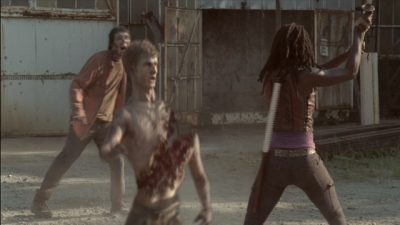 In one episode, a zombie is sliced in half care of Michonne’s katana. KNB made up the face and body, with Stargate doing a digital take-over at the appropriate point. “For the zombie getting sliced in half,” says Hilke, “we have to generate organs and intestines, but we try and make it as natural as possible with the practical elements.” Another zombie kill made use of the actor tucking his arms into his shirt, with Stargate doing fully CG arm extensions that could then be ‘cut’. Similarly, a zombie whose head is cleaved off relied on practical effects and a CG build.
In one episode, a zombie is sliced in half care of Michonne’s katana. KNB made up the face and body, with Stargate doing a digital take-over at the appropriate point. “For the zombie getting sliced in half,” says Hilke, “we have to generate organs and intestines, but we try and make it as natural as possible with the practical elements.” Another zombie kill made use of the actor tucking his arms into his shirt, with Stargate doing fully CG arm extensions that could then be ‘cut’. Similarly, a zombie whose head is cleaved off relied on practical effects and a CG build.
Although the violence may at first sound a little gratuitous, the shots do allow the visual effects artists to have some fun. “In episode 305,” recalls Scalise, “when Rick (Andrew Lincoln) decapitates a zombie in the halls of the prison, Martin Hilke did the shot and took the top half the head, split it and splattered it against the wall and made it slide down.”
Along with decapitations, Stargate Studios has also been responsible for enhancing shots of the prison seen in season three. “Our production designer Graham ‘Grace’ Walker just did a phenomenal job of turning our stages south of Atlanta into the prison,” says Scalise. “We’ve enhanced a number of scenes. In one shot Tyreese (Chad L. Coleman) and the others are coming out of the woods and they see an entrance we’ve never seen before. Stargate had to show this so production didn’t have to build it.”
“They wanted to do a crane move,” continues Scalise, “so the best way to do this and to make it an asset that could be used later was to do a 3D prison. So production built an opening with a broken fence that our actors were able to interact with – it has all the real debris as they’re walking up the hill. As the camera moves up you reveal this whole big burnt out section of the administrative part of the building, which we modeled in Maya, tracked in boujou and comp’d in After Effects.”
So what’s coming for the remainder of season three? Here’s a hint: more decapitations.
Mr. Selfridge
Painting Practice’s visual effects for the ITV Studios series Mr. Selfridge showcase the benefit of good planning when it comes to set design, shooting and post. In particular, Painting Practice was involved with the show, which tells the early 1900s story of Harry Gordon Selfridge and his London department store Selfridges, from production design to previs and final effects shots.
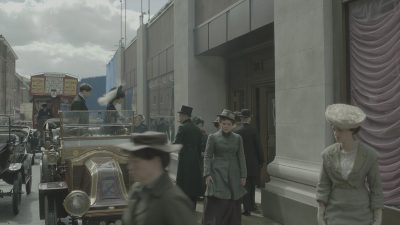
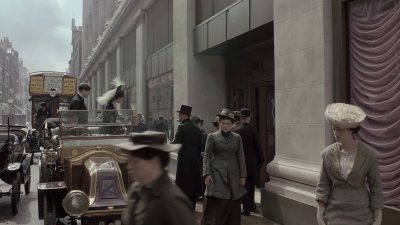
The period drama is set in the first Selfridges store in Oxford Street, London. Exterior scenes were filmed in Kent, necessitating several set extensions and composites by Painting Practice. Prior to set construction by production designer Rob Harris, Painting Practice visual effects supervisor Justin Hutchinson-Chatburn became involved and worked to help decide where CG builds would start and finish.
“I blocked the set out digitally,” explains Justin, “then went in with the previs and I brought the director and production designer in on that process right from the very start. There can sometimes be a huge divide between the art department and the visual effects department – moving from pencil drawings to using 3D tools. But Rob was very receptive to it.”
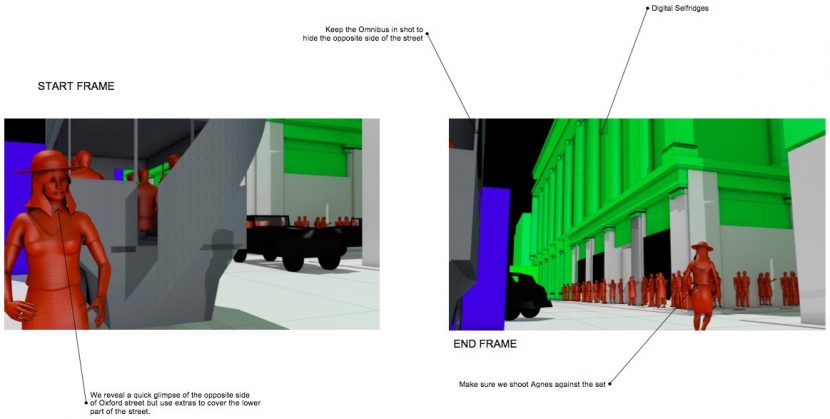
Using Cinema 4D as his main previs tool, Justin created some high-end looking shots, as well as schematic-like plans. “We did basic blocked sets with regular rigged characters and kept it super-basic,” he says. “I also did an overall plan of the set, planning where the greens are. We only had a corner of Selfridges and a little bit of street built, so we had to be very tactical about how to shoot this and get the best out of it.”
“To help everybody understand that, I would do a whole break-out of the set as a PDF schematic,” adds Justin. “This was a 3/4 top-down view that basically had where the greens needed to go, at this part of the day, where the camera needs to be, where the shadows would probably be. And that PDF goes to the gaffer, the DOP, the director, the first and second ADs. It’s a bit like a tech-reccy pack when you go out with an art department.”
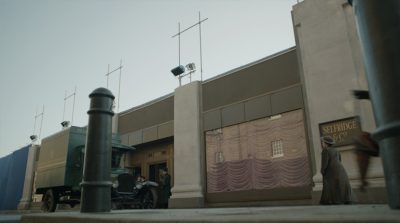
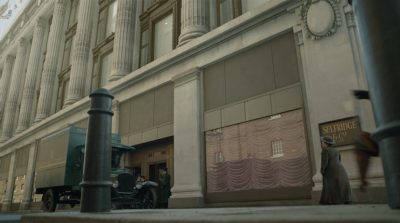
During shooting, Hutchinson-Chatburn had the previs as QuickTimes on an iPad, as well as copies of Cinema 4D and Nuke for quick changes and slap-comps. One aspect the previs helped with in particular was dealing with the small shooting space making it harder to do wide shots. It also provided the filmmakers with a ‘safety’ even if plans did change on the day of shooting. The previs also aided in allowing for sets that could be shot for close-up action against buildings, and then for digital extensions for wider views.
Set extensions relied on a hero CG Selfridges asset combined with extra geometry and elements created in Cinema 4D (including projections) with final comps done in Nuke. Several HDRs were taken on location to serve different scenes. Oftentimes, Painting Practice would be combining two or more separately filmed plates. “One shot was a jib shot of a construction site,” says Justin. “We had a little bit of the set that was the early door for Selfridges and we jibbed over the top of a bus and over the top of that to reveal what would be a giant hole over the back – the construction site. We had to match that with plates that we shot at a different location, and we camera-projected those other plates into that shot.”
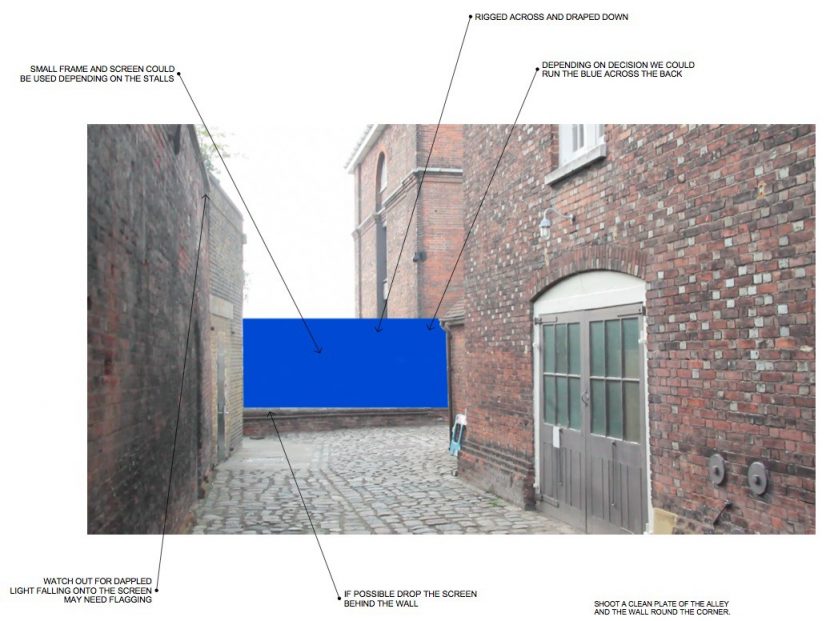
Another particularly challenging sequence involved a timelapse effect as the construction of Selfridges takes place from inside the owner’s office via a 360 degree pan off the window and out the window again. “We shot it in eight different plates, each one locked off at a different degree around the room,” explains Justin. “We had to do seven setups, so the art department were constantly coming in and out changing things, piling boxes of files, changing his desk to effectively cheat the timelapse. The crazy thing was that in the end the pan itself gave us all kinds of horrible strobe effects, so we had to deliver the shot interlaced and not in DPX format to get through the QC.”
Ultimately, Hutchinson-Chatburn says that having shooting planned early worked incredibly well, even though occasionally they would still be thrown an effects ‘curve ball’. “Still, it was actually a good thing because in many ways there’s a tendency to do a big reveal and that can look like a big effects shot. So we’d just go off the side of Selfridges a little bit and see some extra street and see the upper levels. I felt that reading the script and where the drama was playing, it was nicer to reveal it with a sleight of hand.”
Spartacus: War of the Damned
The third season of Spartacus – War of the Damned – will see the dramatic end to the Starz show. Filmed entirely on sound stages in Auckland, New Zealand, Spartacus takes full advantage of greenscreen shooting sets, virtual environments and a concentrated look-dev effort to help bring the Thracian gladiator story to life – a typical show of 52 minutes is shot in only 12 days and this newest ten episode series has 4,400 effects shots.
Watch a breakdown of the VFX in Spartacus: War of the Damned.Filming takes place at re-purposed warehouses and commercial buildings in southern Auckland where production has three 360 degree greenscreen environments and two others which are partial greenscreen sets. The show is filmed on the Panavision Genesis camera, with Vision Research’s Phantom HD cameras relied on for slow-mo shots. Some stylistic shots, especially for fight scenes, have been achieved with camera arrays and a slider rig known as ‘Boris’ that blasts the camera from one end of a six meter rail to the other in one second. The Phantom is also used for shooting practical blood and other effects elements. “We hit these with a lot of specular light because specular highlights help make it look like it’s in the scene,” says the show’s visual effects supervisor Charlie McClellan.
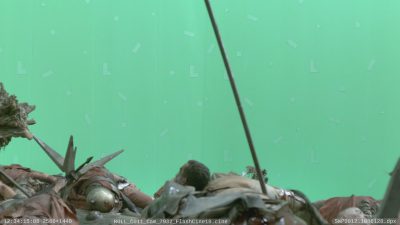
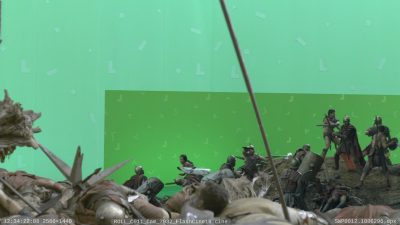
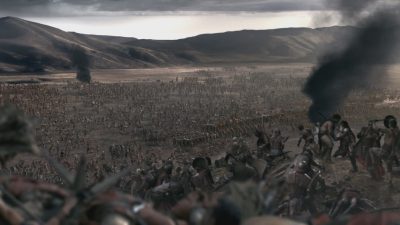
During a shoot, concept work from the art department and proxy 3D environments are sometimes added into the video split to help actors and the filmmakers with eyelines. However, an on-set previs or on-set comp’ing system is not something the team has elected to employ. “We’ve tried some of these,” notes McClellan, “and I am a big advocate, but in a fast TV environment it’s almost impossible to do it properly.”
Instead, the Spartacus visual effects department leans heavily on rapid look-dev from a team of matte painters and 2D and 3D artists. “As we shoot, we take the art department’s concepts and designs, take the footage that’s already been filmed and we’re quickly trying to make sense of the world in a way that we can pass that back to the editorial team,” explains McClellan. “As the production’s being shot, the editor’s pretty much a day behind the shoot – so the assembly’s being done immediately. This means we have to have an incredibly fast turnaround.”
A crucial person behind some of that look-dev work is visual effects art director Peter Baustaedter. “He goes out into the New Zealand environment and takes a lot of the photographs we use as our matte painting elements,” says McClellan. “He goes with one of the best helicopter pilots Tony Monk on the South Island for photographic textures. For example, last season the rebels were camping out on the top of Mount Vesuvius so Peter flew with Tony to White Island and textured the entire cone of the volcano and we used that exclusively for the re-building of the top of the mountain.”
The look-dev begins with taking still frames of all the hero angles for a particular scene and creating still frame key concepts for director, DOP and art director sign-off. “We will then go and build a sequence out of each scene,” explains McClellan. “Usually it’s based on the same still images – but now we’re going for a sequence in each scene so we can show it with all the bells and whistles in place. You get a little clip reel – almost a ‘This week on Spartacus’ – and you see how the episode’s going to be made even before we’ve done it! It’s all about prototyping. It’s the only way to get through 4,400 effects shots in ten episodes.”
Then, McClellan will go through the locked cut and assess the greenscreen photography to see where in the CG environment the camera is actually looking. “We’ll meticulously do layouts for every setup, not every shot but every camera setup in the entire episode – we’ll give a layout frame,” he says. “So when we hand over this material to the vendors they get finished matte paintings, Nuke script environments reference color-graded frames with and without LUTs applied.”
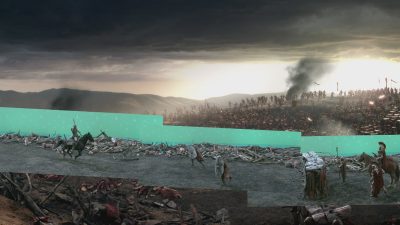
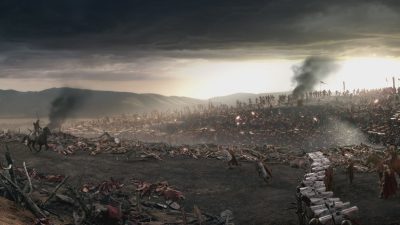
The main visual effects studios responsible for the work in War of the Damned are 3DCGI, Phi FX, Digipost, Cause+FX, ImagesPost, Effects Lab and Toybox. McClellan’s preference is to shoot vignettes of action and comp these in, although CG crowds do feature. “At a certain distance from camera we transfer to Massive, which John Sheils’ 3DCGI is responsible for. Massive’s motion capture tree matches well with what you get when you fill a greenscreen stage with stunties and give them shields and tell them to start hacking away at each other – the overall nature of the motion is coincidentally similar.”
For McClellan, the ability to deliver more than 4,000 shots over ten episodes has been, in his words, “a mind-boggling feat,” just simply to keep track of the data and creative requirements. But, he says, he has enjoyed working on a show, albeit with some odd conversations. “Sometimes we have to talk about whether the eyeballs will fly past camera, or, will the brains slide out? The violence is very visceral. I’m looking for a Teletubbies show next…”

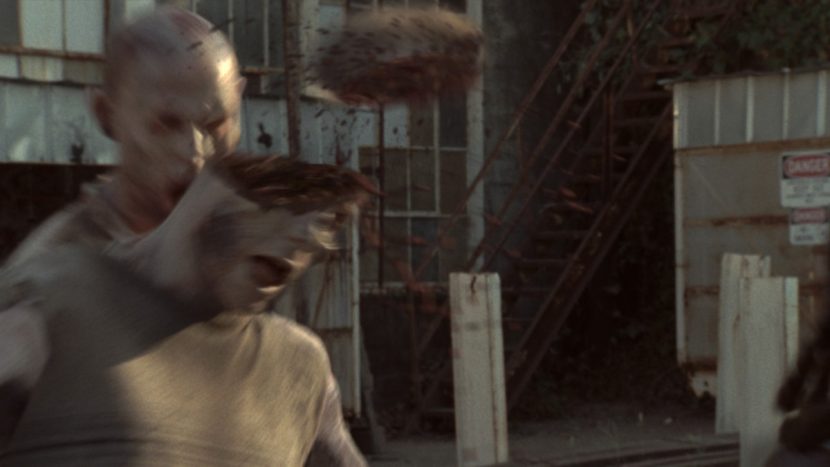
VFX Breakdown from Stargate Studios for Walking Dead Season 3 : https://vimeo.com/63430867
For others seasons breakdowns, let’s check http://wiki-fx.net/the-walking-dead/ 🙂